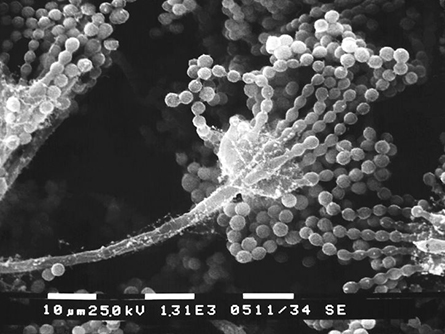A mold’s dangerous responses to its environment
Aflatoxins are among the most dangerous of natural products. At a high dose, the toxins can cause fatal liver failure; at lower doses, by forming adducts with guanine bases in DNA, they can cause mutations that lead to liver cancer.

The toxins are made by filamentous fungi in the Aspergillus family found in soil and are able to colonize the grains and seeds that constitute many of the world's most important food crops. Aspergilli don't need aflatoxins to survive; they activate aflatoxin synthesis in response to environmental conditions, especially heat and moisture. Since hotter days are coming worldwide, researchers would like to find strategies to reduce aflatoxin production.
The genome of Aspergillus flavus, the chief culprit in introducing aflatoxin to human and animal food supplies, first was sequenced in 2006. But there's a difference between knowing what sequences are in a genome and knowing what they do; many sections of the A. flavus genome have not been annotated, meaning that researchers have had little insight into their function.
In a recent article in the journal Molecular & Cellular Proteomics, researchers at the Fujian Agriculture and Forestry University in China, led by Mingkun Yang, report on a proteogenomic analysis of A. flavus. By using the whole fungal genome instead of only its known coding sequences as the reference database to identify peptides detected through mass spectrometry, the team discovered over 700 new protein-coding genes.
"The authors provide a significant improvement to the genome annotation in Aspergillus and demonstrate the use of proteogenomics as a tool especially in organisms lacking high-quality genome annotations," one anonymous peer reviewer wrote.
Researchers cultured the fungus under cold, salty and oxidative stress conditions to maximize phenotypic variability, and they were rewarded: The fungi expressed a smorgasbord of proteoforms, including over 200 new-to-science splice variants, some single-amino-acid variants and a few unexpected intergenic peptides. In follow-up quantitative PCR experiments, the researchers observed that stressful conditions substantially affected the expression of some of the new genes.
Based on homology to other, better-annotated proteins in the literature, the authors think that they may have identified new metabolic enzymes, signaling proteins and stress response factors. They have not yet determined whether any of the new genes are involved in aflatoxin production.
According to the researchers, follow-up studies of the new protein-coding genes and when and where they are expressed may improve our understanding of when and why aflatoxin is produced.
Enjoy reading ASBMB Today?
Become a member to receive the print edition four times a year and the digital edition monthly.
Learn moreGet the latest from ASBMB Today
Enter your email address, and we’ll send you a weekly email with recent articles, interviews and more.
Latest in Science
Science highlights or most popular articles

Mining microbes for rare earth solutions
Joseph Cotruvo, Jr., will receive the ASBMB Mildred Cohn Young Investigator Award at the ASBMB Annual Meeting, March 7–10, just outside of Washington, D.C.

Fueling healthier aging, connecting metabolism stress and time
Biochemist Melanie McReynolds investigates how metabolism and stress shape the aging process. Her research on NAD+, a molecule central to cellular energy, reveals how maintaining its balance could promote healthier, longer lives.

Mapping proteins, one side chain at a time
Roland Dunbrack Jr. will receive the ASBMB DeLano Award for Computational Biosciences at the ASBMB Annual Meeting, March 7–10, just outside of Washington, D.C.

Exploring the link between lipids and longevity
Meng Wang will present her work on metabolism and aging at the ASBMB Annual Meeting, March 7-10, just outside of Washington, D.C.

Defining a ‘crucial gatekeeper’ of lipid metabolism
George Carman receives the Herbert Tabor Research Award at the ASBMB Annual Meeting, March 7–10, just outside of Washington, D.C.

The science of staying strong
Muscles power every movement, but they also tell the story of aging itself. Scientists are uncovering how strength fades, why some species resist it and what lifestyle and molecular clues could help preserve muscle health for life.

